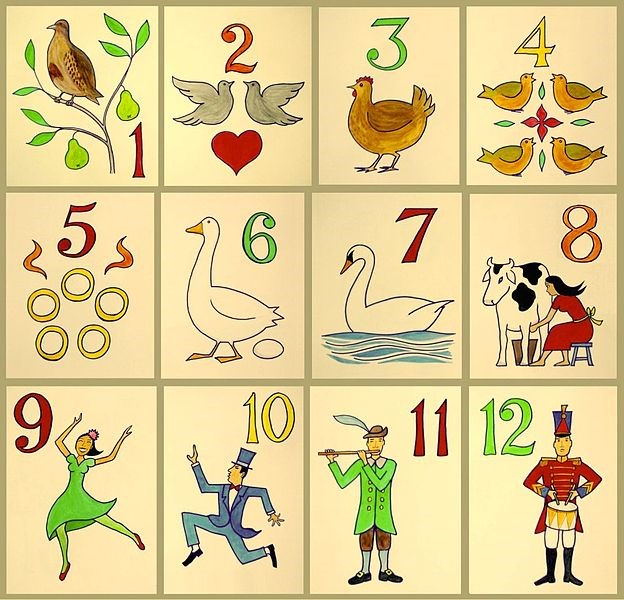
The True Meaning of the Christmas Carol the Twelve Days of Christmas

On December the 25th we celebrated the birth of Christ the Savior and the beginning of the twelve days of Christmas that is the countdown to the Feast of Epiphany. The Christmas season, however, doesn’t end officially until after the Feast of the Epiphany on the following Sunday when we celebrate the Baptism of the Lord, which becomes the First Sunday in Ordinary Time. During the twelve day period between Christmas and Epiphany, a popular Christmas carol is “The Twelve Days of Christmas,” a song written in 16th century England during a time of intense religious persecution of Catholics. The persecution began when the government of England ordered the church in England to separate from the Roman Catholic Church, forming its own apostate church. The reason for the separation was because Pope Clement VII refused to grant King Henry the VIII an annulment from his twenty year marriage to Queen Catherine so he could marry his pregnant mistress, Anne Boleyn. During this time, and under the reigns of Henry’s two Protestant children Edward VI and Elizabeth I, many Catholics, including priests, were burned alive as martyrs of the faith. Each line of the song was written for the purpose of using symbols that were catechetical devises to secretly teach children about the Catholic faith, a crime in England at that time.
“On the first day of Christmas, my true love gave to me, a partridge in a pear tree”: “My true love” refers to God (Father, Son, and Holy Spirit). The “me” is the individual Catholic who is called to remain faithful to the teachings of Jesus Christ and His gift that is the Church. The symbolic meaning of the partridge and the pear tree will be revealed at the end of the song when the phrase is repeated.
“two turtle doves” symbolize the two natures of Jesus who is fully human and fully divine, and the two Testaments, the Old and New that together comprise the Christian canon of Sacred Scripture. They are like the two lungs in the body of a healthy person that sustains life in the same way that the study of the Sacred Scriptures in the Old and New Testaments are necessary to the healthy life of the Church.
“three French hens” are the three gifts the Wise Men gave the Christ child (gold, frankincense, and myrrh), and the Three Persons of the Godhead (Father, Son, and Holy Spirit).
“four calling birds” are the Four Gospels of Sts Matthew, Mark, Luke, and John that record the accounts of Jesus’ ministry in His miracles that proclaim His messiahship and His teachings that calls all men and women to a New Covenant in the era of the Church, Jesus’ Kingdom of Heaven on earth.
“five golden rings” are the first five books of the Old Testament which tell the history of the beginning of God’s relationship with mankind and the beginning of His relationship with the children of Israel as His first covenant people called out from the other peoples of the world.
“six geese a laying” are the six days of creation and the
six commandments of the Church.
The six commandments of the Catholic Church were “Catechism
of Christian Doctrine” approved by the Catholic bishops of England:
This list is the same as that which the Fathers of the Third Plenary Council of Baltimore prescribed for the United States in 1886. Today, these commands are summarized in the five precepts of the Church in the Universal Catechism (see CCC 2041-46).
“seven swans a swimming” are symbols for the Seven Sacraments of faith given to us by Christ Himself to sustain the faithful on their journey to salvation and the seven petitions of the “Our Father” prayer Jesus taught His disciples.
“eight maids a milking” represent Jesus’ spiritual teaching on a transformed life that provides the pathway to heaven in the New Covenant Law of the Beatitudes (Matthew 5:1-12).
“nine ladies dancing” are the nine orders of angels that serve God in the heavenly Sanctuary and which He sometimes sends to earth as His messengers. Scripture lists them as Angels, Archangels, Virtues, Powers, Principalities, Dominions, Thrones, Cherubim, and Seraphim.
“ten lords a-leaping” are the Ten Commandments that are binding upon the people of God both in the Old and New Covenants (Exodus 20:3-17; Deuteronomy 5:7-21; CCC 2067-68).
“eleven pipers piping” are the eleven Apostles who remained faithful after the treachery of Judas Iscariot. They are examples of how every Catholic Christian is to remain faithful to Jesus and His Church. Jesus appeared to them after His resurrection, breathing upon them His Spirit and giving them the power to govern His Church by forgiving sins in the Sacrament of Reconciliation (John 20:21-23).
“twelve lords a-leaping” are the twelve fundamental beliefs of the Catholic Church presented in the Apostles Creed.
“and a partridge in a pear tree”: a partridge is a common ground game bird in England that does not roost or make its nests in trees, so a partridge in a tree is an uncommon sight. The “partridge” is a symbol for the Messiah, Jesus Christ, and the “pear tree” is the Cross upon which Jesus offered up the gift of His life for the salvation of the world.
So, the next time you sing the song, remember it is not about twelve unusual gifts during the twelve days of Christmas. It is instead twelve gifts of love from God the Son to the people of His Kingdom, the Catholic (universal) Church.
Michal Hunt, Copyright © 2014, revised 2019; Agape Bible Study. Permissions All Rights Reserved.